How to write a resume?
Create your free resume in minutes with TrueResume. Choose from HR-approved templates and build your professional resume effortlessly
1000+ Reviews on Trustpilot
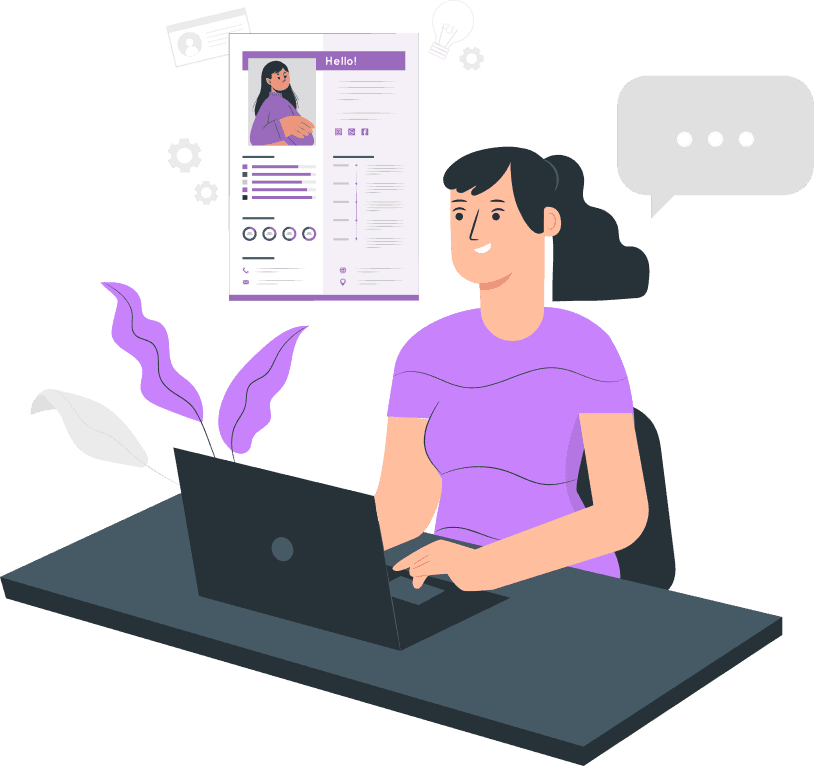
How to write a resume?
Create your free resume in minutes with TrueResume. Choose from HR-approved templates and build your professional resume effortlessly
1000+ Reviews on Trustpilot

How to write a resume?
Create your free resume in minutes with TrueResume. Choose from HR-approved templates and build your professional resume effortlessly
1000+ Reviews on Trustpilot

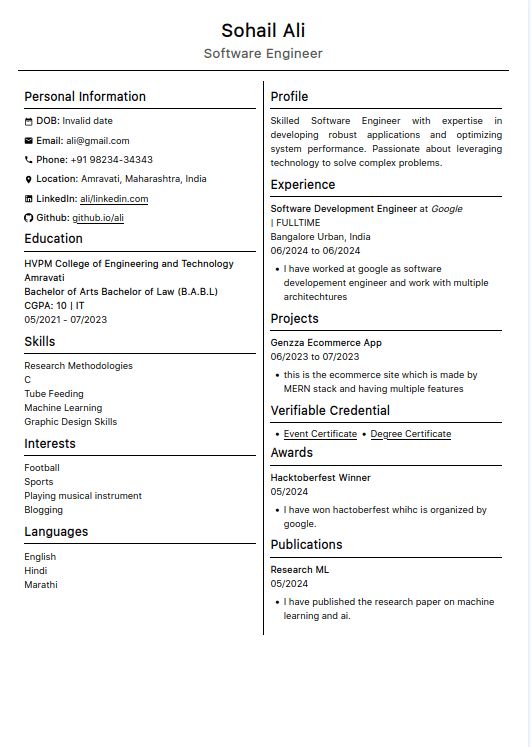
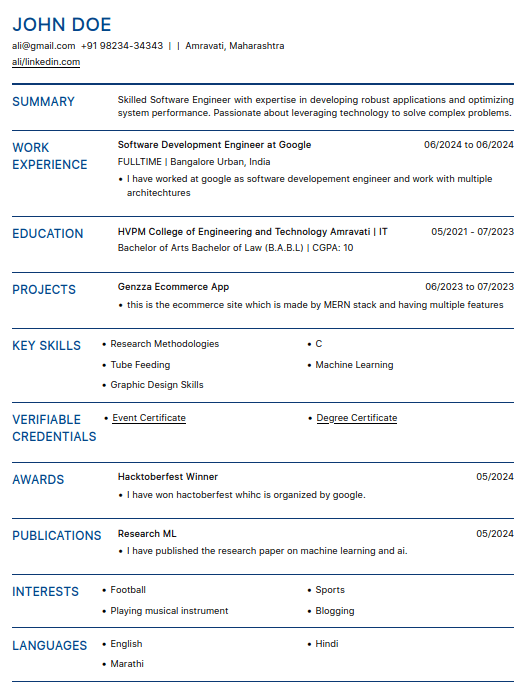
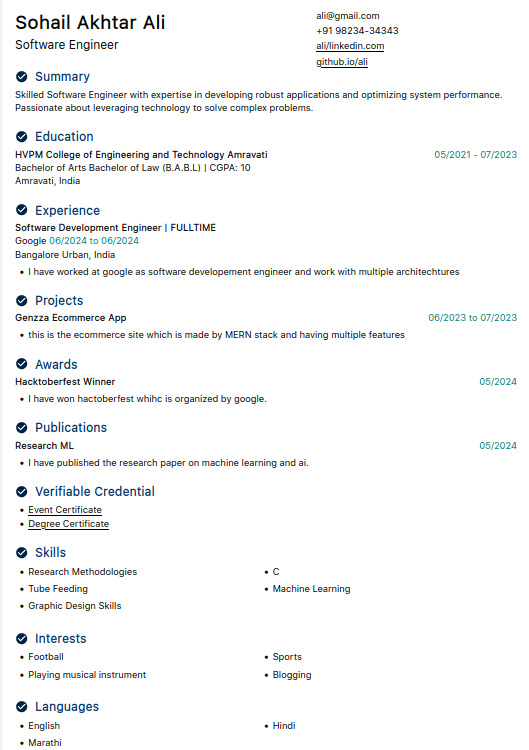
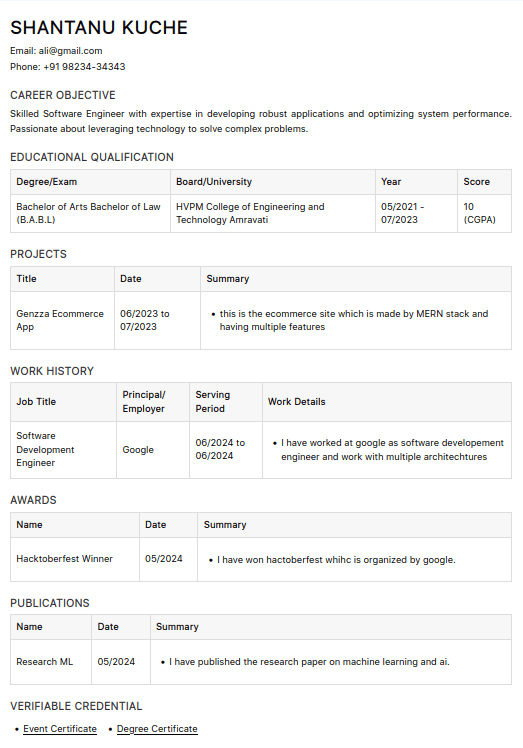
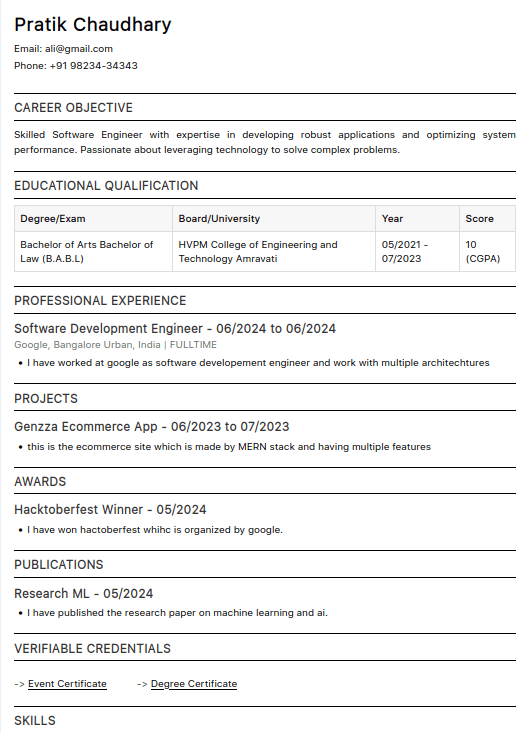
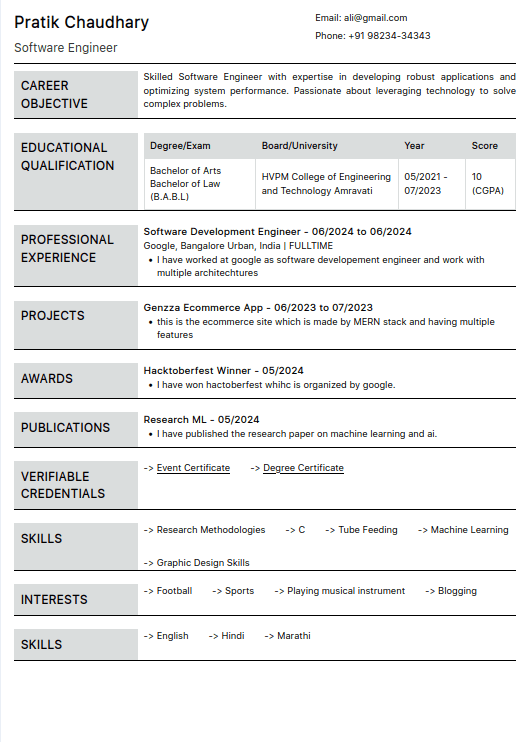












Introduction
A resume is a brief summary of your qualifications, education, and experiences relevant to your job search objective. The purpose of a resume is to obtain an interview. Employers will spend less than 30 seconds reviewing your resume; therefore, the information must be conveyed in a clear, well-organized style. In this article we will look forward to how to make a job winning resume? How can we optimize your resume? What is the purpose of a resume in finding job opportunities?
Resume is not just a page of a profile summary, it is your first impression and it will decide your next step towards your job opportunity. Crafting a resume is a very time consuming process. We are here to help you to save your time So you can focus on your interview.
Introduction
A resume is a brief summary of your qualifications, education, and experiences relevant to your job search objective. The purpose of a resume is to obtain an interview. Employers will spend less than 30 seconds reviewing your resume; therefore, the information must be conveyed in a clear, well-organized style. In this article we will look forward to how to make a job winning resume? How can we optimize your resume? What is the purpose of a resume in finding job opportunities?
Resume is not just a page of a profile summary, it is your first impression and it will decide your next step towards your job opportunity. Crafting a resume is a very time consuming process. We are here to help you to save your time So you can focus on your interview.
Introduction
A resume is a brief summary of your qualifications, education, and experiences relevant to your job search objective. The purpose of a resume is to obtain an interview. Employers will spend less than 30 seconds reviewing your resume; therefore, the information must be conveyed in a clear, well-organized style. In this article we will look forward to how to make a job winning resume? How can we optimize your resume? What is the purpose of a resume in finding job opportunities?
Resume is not just a page of a profile summary, it is your first impression and it will decide your next step towards your job opportunity. Crafting a resume is a very time consuming process. We are here to help you to save your time So you can focus on your interview.
What is the purpose of a Resume?
The main purpose of a resume is to land your dream job in your dream Company. To achieve this purpose your main objective is to showcase your Skills, education and experience. It is an informational document that focuses on your detailed information. By reviewing your Resume an employer will make a decision easily to move with you or not.
What is the purpose of a Resume?
The main purpose of a resume is to land your dream job in your dream Company. To achieve this purpose your main objective is to showcase your Skills, education and experience. It is an informational document that focuses on your detailed information. By reviewing your Resume an employer will make a decision easily to move with you or not.
What is the purpose of a Resume?
The main purpose of a resume is to land your dream job in your dream Company. To achieve this purpose your main objective is to showcase your Skills, education and experience. It is an informational document that focuses on your detailed information. By reviewing your Resume an employer will make a decision easily to move with you or not.
How Resume play an important role in a job career?
A Resume plays a very important role in a job journey. It highlights your most relevant skills and experiences to the recruiter. It can also secure your first interview after selecting in the resume selection process. If you're just starting your career in the Corporate world or you are an experienced employee. It helps you land a job in your dream company. Whenever you are applying for a different job just consider crafting your resume accordingly. We are here to help with your resume making journey. You only need to focus on enhancing your technical skills and communications.
How Resume play an important role in a job career?
A Resume plays a very important role in a job journey. It highlights your most relevant skills and experiences to the recruiter. It can also secure your first interview after selecting in the resume selection process. If you're just starting your career in the Corporate world or you are an experienced employee. It helps you land a job in your dream company. Whenever you are applying for a different job just consider crafting your resume accordingly. We are here to help with your resume making journey. You only need to focus on enhancing your technical skills and communications.
How Resume play an important role in a job career?
A Resume plays a very important role in a job journey. It highlights your most relevant skills and experiences to the recruiter. It can also secure your first interview after selecting in the resume selection process. If you're just starting your career in the Corporate world or you are an experienced employee. It helps you land a job in your dream company. Whenever you are applying for a different job just consider crafting your resume accordingly. We are here to help with your resume making journey. You only need to focus on enhancing your technical skills and communications.
How are resumes useful for your first job?
When you are ready to enter the job market it is very important to showcase all your information in some particular format. So, the recruiter can understand your profile and make decisions. In a Resume you generally can add the basic details like your Name, Contact details, Profile Summary, Technical and soft skills, education and experience. This all information increases your chances of getting shortlisted by the recruiters and HR managers. This informational documents also use in the following way:
Introducing Yourself to Employers: A resume acts as a professional introduction, giving employers a first look at who you are and what you bring to the table.
Presenting to Employers: Resumes are often sent to potential employers as a formal application for job openings. They provide a snapshot of your qualifications and experience.
Showcasing Your Skills: Resumes highlight your key skills and abilities, demonstrating to employers how you can contribute to their organization.
How are resumes useful for your first job?
When you are ready to enter the job market it is very important to showcase all your information in some particular format. So, the recruiter can understand your profile and make decisions. In a Resume you generally can add the basic details like your Name, Contact details, Profile Summary, Technical and soft skills, education and experience. This all information increases your chances of getting shortlisted by the recruiters and HR managers. This informational documents also use in the following way:
Introducing Yourself to Employers: A resume acts as a professional introduction, giving employers a first look at who you are and what you bring to the table.
Presenting to Employers: Resumes are often sent to potential employers as a formal application for job openings. They provide a snapshot of your qualifications and experience.
Showcasing Your Skills: Resumes highlight your key skills and abilities, demonstrating to employers how you can contribute to their organization.
How are resumes useful for your first job?
When you are ready to enter the job market it is very important to showcase all your information in some particular format. So, the recruiter can understand your profile and make decisions. In a Resume you generally can add the basic details like your Name, Contact details, Profile Summary, Technical and soft skills, education and experience. This all information increases your chances of getting shortlisted by the recruiters and HR managers. This informational documents also use in the following way:
Introducing Yourself to Employers: A resume acts as a professional introduction, giving employers a first look at who you are and what you bring to the table.
Presenting to Employers: Resumes are often sent to potential employers as a formal application for job openings. They provide a snapshot of your qualifications and experience.
Showcasing Your Skills: Resumes highlight your key skills and abilities, demonstrating to employers how you can contribute to their organization.
How are your resumes used by the employer?
Employers use resumes as an important tool in the hiring process to evaluate potential candidates. They serve as a first impression, helping employers quickly assess whether a candidate’s qualifications, skills, and experience match the job requirements. Key ways employers utilize resumes include:
Screening Candidates: Employers review resumes to filter out applicants who do not meet the basic criteria for the position.
Assessing Fit: Resumes provide insight into a candidate’s professional background, helping employers determine if they are a good fit for the company culture and job role.
Guiding Interview Questions: Employers use the information on a resume to formulate specific questions during the interview, focusing on the candidate's relevant experience and accomplishments.
Comparing Applicants: Resumes allow employers to compare different candidates side by side, making it easier to identify the most qualified individuals for further consideration.
How are your resumes used by the employer?
Employers use resumes as an important tool in the hiring process to evaluate potential candidates. They serve as a first impression, helping employers quickly assess whether a candidate’s qualifications, skills, and experience match the job requirements. Key ways employers utilize resumes include:
Screening Candidates: Employers review resumes to filter out applicants who do not meet the basic criteria for the position.
Assessing Fit: Resumes provide insight into a candidate’s professional background, helping employers determine if they are a good fit for the company culture and job role.
Guiding Interview Questions: Employers use the information on a resume to formulate specific questions during the interview, focusing on the candidate's relevant experience and accomplishments.
Comparing Applicants: Resumes allow employers to compare different candidates side by side, making it easier to identify the most qualified individuals for further consideration.
How are your resumes used by the employer?
Employers use resumes as an important tool in the hiring process to evaluate potential candidates. They serve as a first impression, helping employers quickly assess whether a candidate’s qualifications, skills, and experience match the job requirements. Key ways employers utilize resumes include:
Screening Candidates: Employers review resumes to filter out applicants who do not meet the basic criteria for the position.
Assessing Fit: Resumes provide insight into a candidate’s professional background, helping employers determine if they are a good fit for the company culture and job role.
Guiding Interview Questions: Employers use the information on a resume to formulate specific questions during the interview, focusing on the candidate's relevant experience and accomplishments.
Comparing Applicants: Resumes allow employers to compare different candidates side by side, making it easier to identify the most qualified individuals for further consideration.
Tips for Creating a Successful Resumes:
Do’s
Do design your descriptions to focus on your accomplishments, using action verbs to clearly indicate the skills you’ve used. See Sample Action Verb list on the next page.
Do try quantifying results in your descriptions, such as “Created marketing campaign that increased club membership by 25%.”
Do keep your resume brief enough to fit on one page (or two pages if your experience is extensive).
Do print your resume on good quality bond paper, either white or conservative tones. If printed on plain computer paper, copy onto good quality bond paper.
Do accompany your resume with a cover letter in most cases.
Do have others look over your resume for content and grammar. Career Counselors are available at the career center to critique your resume
Don'ts
Don’t make your margins and font size too small: margins no smaller than one inch and font size no smaller than 10 points.
Don’t include personal pronouns (e.g. I, me, we).
Don’t include personal information, physical characteristics, or photographs on your resume. However, individuals from other countries may include these on their resumes.
Don’t include the last line: “References available upon request”.
Tips for Creating a Successful Resumes:
Do’s
Do design your descriptions to focus on your accomplishments, using action verbs to clearly indicate the skills you’ve used. See Sample Action Verb list on the next page.
Do try quantifying results in your descriptions, such as “Created marketing campaign that increased club membership by 25%.”
Do keep your resume brief enough to fit on one page (or two pages if your experience is extensive).
Do print your resume on good quality bond paper, either white or conservative tones. If printed on plain computer paper, copy onto good quality bond paper.
Do accompany your resume with a cover letter in most cases.
Do have others look over your resume for content and grammar. Career Counselors are available at the career center to critique your resume
Don'ts
Don’t make your margins and font size too small: margins no smaller than one inch and font size no smaller than 10 points.
Don’t include personal pronouns (e.g. I, me, we).
Don’t include personal information, physical characteristics, or photographs on your resume. However, individuals from other countries may include these on their resumes.
Don’t include the last line: “References available upon request”.
Tips for Creating a Successful Resumes:
Do’s
Do design your descriptions to focus on your accomplishments, using action verbs to clearly indicate the skills you’ve used. See Sample Action Verb list on the next page.
Do try quantifying results in your descriptions, such as “Created marketing campaign that increased club membership by 25%.”
Do keep your resume brief enough to fit on one page (or two pages if your experience is extensive).
Do print your resume on good quality bond paper, either white or conservative tones. If printed on plain computer paper, copy onto good quality bond paper.
Do accompany your resume with a cover letter in most cases.
Do have others look over your resume for content and grammar. Career Counselors are available at the career center to critique your resume
Don'ts
Don’t make your margins and font size too small: margins no smaller than one inch and font size no smaller than 10 points.
Don’t include personal pronouns (e.g. I, me, we).
Don’t include personal information, physical characteristics, or photographs on your resume. However, individuals from other countries may include these on their resumes.
Don’t include the last line: “References available upon request”.
How to create a professional resume?
Crafting a professional resume is an essential step in landing your dream job. Your resume serves as a marketing tool that showcases your skills, experiences, and accomplishments.
Adding the Below section in a resume increases the chance of getting your resume shortlisted. Here We Explain briefly a Full guide on how to write a Professional resume that stands out.
How to create a professional resume?
Crafting a professional resume is an essential step in landing your dream job. Your resume serves as a marketing tool that showcases your skills, experiences, and accomplishments.
Adding the Below section in a resume increases the chance of getting your resume shortlisted. Here We Explain briefly a Full guide on how to write a Professional resume that stands out.
How to create a professional resume?
Crafting a professional resume is an essential step in landing your dream job. Your resume serves as a marketing tool that showcases your skills, experiences, and accomplishments.
Adding the Below section in a resume increases the chance of getting your resume shortlisted. Here We Explain briefly a Full guide on how to write a Professional resume that stands out.
Start with Choosing the Right Resume Formats and templates for your Skills and knowledge.
Choosing the right resume templates will help you to showcase your skills, education and knowledge in the best possible way and the pre formatted resume easily makes your resume layout friendly and gives a professional look.
You can select your resume templates by clicking on the below Free Resume Templates or you can explore more.
Add Strong Header
Personal Information: Add your full name, phone number, email address, and LinkedIn profile. Ensure your email address is professional, using your name rather than a nickname.
Professional Title: Below your name, add a title that reflects your career goals. This should be tailored to the job you're applying for, such as "Digital Marketing Specialist" or "Experienced Software Engineer."
Write a Compelling Resume Summary or Objective
Resume Summary: A brief statement that highlights your professional achievements and skills. It's ideal for candidates with several years of experience in their field.
Resume Objective: Focuses on your career goals and what you aim to achieve in your next role. This is more common for entry-level candidates or those changing careers.
Highlight Your Work Experience
Job Titles and Companies: List your job titles, company names, locations, and dates of employment. Use bullet points to describe your responsibilities and achievements in each role.
Quantify Your Achievements: Whenever possible, use numbers to demonstrate your impact, such as "Increased sales by 20%" or "Managed a team of 10 people."
Tailor to the Job Description: Customize your work experience section to match the job you're applying for. Highlight the most relevant experience and skills.
Showcase Your Education
Degree and Institution: Include the degree you earned, the name of the institution, and the graduation date. If you're a recent graduate, you can also include relevant coursework or academic honors.
Certifications and Training: If you have completed any certifications or additional training relevant to the job, list them here.
Add Key Skills
Hard Skills: These are job-specific abilities like programming languages, software proficiency, or foreign languages. Include skills that are directly relevant to the position.
Soft Skills: These are personal attributes like communication, teamwork, or problem-solving. While harder to quantify, they are often just as important to employers.
Include Additional Sections (Optional)
Projects: If you’ve worked on relevant projects, include a brief description of your role and the outcomes. This is especially useful for candidates in fields like IT or engineering.
Volunteer Work: Volunteering can demonstrate valuable skills and a commitment to your community. Include this if it’s relevant to the job or shows skills that employers value.
Languages: If you are fluent in more than one language, include this information. Being bilingual or multilingual can be a significant asset.
Format Your Resume for Readability
Use Bullet Points: Bullet points make your resume easy to scan. Use them to list achievements and responsibilities rather than writing long paragraphs.
Keep it to One Page: Ideally, your resume should be one page long, especially if you have less than 10 years of experience. If necessary, a two-page resume is acceptable, but ensure every word counts.
Choose a Professional Font: Use a clean, easy-to-read font like Arial, Calibri, or Times New Roman, and keep the font size between 10 and 12 points.
Proofread and Edit
Check for Spelling and Grammar: Typos and grammatical errors can make a bad impression. Carefully proofread your resume, or ask a friend or professional to review it for you.
Consistency: Ensure that the formatting, fonts, and style are consistent throughout the resume. This shows attention to detail and professionalism.
Tailor Your Resume for Each Job Application
Use Keywords from the Job Description: Many companies use Applicant Tracking Systems (ATS) to scan resumes. By including relevant keywords from the job description, you increase your chances of passing the initial screening.
Customize Your Summary: Adjust your resume summary or objective to align with the specific role you’re applying for, highlighting the most relevant skills and experience.
Add a Cover Letter (Optional but Recommended)
Personalize Your Cover Letter: While not always required, a cover letter can enhance your application by providing context and explaining why you're a perfect fit for the role.
Start with Choosing the Right Resume Formats and templates for your Skills and knowledge.
Choosing the right resume templates will help you to showcase your skills, education and knowledge in the best possible way and the pre formatted resume easily makes your resume layout friendly and gives a professional look.
You can select your resume templates by clicking on the below Free Resume Templates or you can explore more.
Add Strong Header
Personal Information: Add your full name, phone number, email address, and LinkedIn profile. Ensure your email address is professional, using your name rather than a nickname.
Professional Title: Below your name, add a title that reflects your career goals. This should be tailored to the job you're applying for, such as "Digital Marketing Specialist" or "Experienced Software Engineer."
Write a Compelling Resume Summary or Objective
Resume Summary: A brief statement that highlights your professional achievements and skills. It's ideal for candidates with several years of experience in their field.
Resume Objective: Focuses on your career goals and what you aim to achieve in your next role. This is more common for entry-level candidates or those changing careers.
Highlight Your Work Experience
Job Titles and Companies: List your job titles, company names, locations, and dates of employment. Use bullet points to describe your responsibilities and achievements in each role.
Quantify Your Achievements: Whenever possible, use numbers to demonstrate your impact, such as "Increased sales by 20%" or "Managed a team of 10 people."
Tailor to the Job Description: Customize your work experience section to match the job you're applying for. Highlight the most relevant experience and skills.
Showcase Your Education
Degree and Institution: Include the degree you earned, the name of the institution, and the graduation date. If you're a recent graduate, you can also include relevant coursework or academic honors.
Certifications and Training: If you have completed any certifications or additional training relevant to the job, list them here.
Add Key Skills
Hard Skills: These are job-specific abilities like programming languages, software proficiency, or foreign languages. Include skills that are directly relevant to the position.
Soft Skills: These are personal attributes like communication, teamwork, or problem-solving. While harder to quantify, they are often just as important to employers.
Include Additional Sections (Optional)
Projects: If you’ve worked on relevant projects, include a brief description of your role and the outcomes. This is especially useful for candidates in fields like IT or engineering.
Volunteer Work: Volunteering can demonstrate valuable skills and a commitment to your community. Include this if it’s relevant to the job or shows skills that employers value.
Languages: If you are fluent in more than one language, include this information. Being bilingual or multilingual can be a significant asset.
Format Your Resume for Readability
Use Bullet Points: Bullet points make your resume easy to scan. Use them to list achievements and responsibilities rather than writing long paragraphs.
Keep it to One Page: Ideally, your resume should be one page long, especially if you have less than 10 years of experience. If necessary, a two-page resume is acceptable, but ensure every word counts.
Choose a Professional Font: Use a clean, easy-to-read font like Arial, Calibri, or Times New Roman, and keep the font size between 10 and 12 points.
Proofread and Edit
Check for Spelling and Grammar: Typos and grammatical errors can make a bad impression. Carefully proofread your resume, or ask a friend or professional to review it for you.
Consistency: Ensure that the formatting, fonts, and style are consistent throughout the resume. This shows attention to detail and professionalism.
Tailor Your Resume for Each Job Application
Use Keywords from the Job Description: Many companies use Applicant Tracking Systems (ATS) to scan resumes. By including relevant keywords from the job description, you increase your chances of passing the initial screening.
Customize Your Summary: Adjust your resume summary or objective to align with the specific role you’re applying for, highlighting the most relevant skills and experience.
Add a Cover Letter (Optional but Recommended)
Personalize Your Cover Letter: While not always required, a cover letter can enhance your application by providing context and explaining why you're a perfect fit for the role.
Start with Choosing the Right Resume Formats and templates for your Skills and knowledge.
Choosing the right resume templates will help you to showcase your skills, education and knowledge in the best possible way and the pre formatted resume easily makes your resume layout friendly and gives a professional look.
You can select your resume templates by clicking on the below Free Resume Templates or you can explore more.
Add Strong Header
Personal Information: Add your full name, phone number, email address, and LinkedIn profile. Ensure your email address is professional, using your name rather than a nickname.
Professional Title: Below your name, add a title that reflects your career goals. This should be tailored to the job you're applying for, such as "Digital Marketing Specialist" or "Experienced Software Engineer."
Write a Compelling Resume Summary or Objective
Resume Summary: A brief statement that highlights your professional achievements and skills. It's ideal for candidates with several years of experience in their field.
Resume Objective: Focuses on your career goals and what you aim to achieve in your next role. This is more common for entry-level candidates or those changing careers.
Highlight Your Work Experience
Job Titles and Companies: List your job titles, company names, locations, and dates of employment. Use bullet points to describe your responsibilities and achievements in each role.
Quantify Your Achievements: Whenever possible, use numbers to demonstrate your impact, such as "Increased sales by 20%" or "Managed a team of 10 people."
Tailor to the Job Description: Customize your work experience section to match the job you're applying for. Highlight the most relevant experience and skills.
Showcase Your Education
Degree and Institution: Include the degree you earned, the name of the institution, and the graduation date. If you're a recent graduate, you can also include relevant coursework or academic honors.
Certifications and Training: If you have completed any certifications or additional training relevant to the job, list them here.
Add Key Skills
Hard Skills: These are job-specific abilities like programming languages, software proficiency, or foreign languages. Include skills that are directly relevant to the position.
Soft Skills: These are personal attributes like communication, teamwork, or problem-solving. While harder to quantify, they are often just as important to employers.
Include Additional Sections (Optional)
Projects: If you’ve worked on relevant projects, include a brief description of your role and the outcomes. This is especially useful for candidates in fields like IT or engineering.
Volunteer Work: Volunteering can demonstrate valuable skills and a commitment to your community. Include this if it’s relevant to the job or shows skills that employers value.
Languages: If you are fluent in more than one language, include this information. Being bilingual or multilingual can be a significant asset.
Format Your Resume for Readability
Use Bullet Points: Bullet points make your resume easy to scan. Use them to list achievements and responsibilities rather than writing long paragraphs.
Keep it to One Page: Ideally, your resume should be one page long, especially if you have less than 10 years of experience. If necessary, a two-page resume is acceptable, but ensure every word counts.
Choose a Professional Font: Use a clean, easy-to-read font like Arial, Calibri, or Times New Roman, and keep the font size between 10 and 12 points.
Proofread and Edit
Check for Spelling and Grammar: Typos and grammatical errors can make a bad impression. Carefully proofread your resume, or ask a friend or professional to review it for you.
Consistency: Ensure that the formatting, fonts, and style are consistent throughout the resume. This shows attention to detail and professionalism.
Tailor Your Resume for Each Job Application
Use Keywords from the Job Description: Many companies use Applicant Tracking Systems (ATS) to scan resumes. By including relevant keywords from the job description, you increase your chances of passing the initial screening.
Customize Your Summary: Adjust your resume summary or objective to align with the specific role you’re applying for, highlighting the most relevant skills and experience.
Add a Cover Letter (Optional but Recommended)
Personalize Your Cover Letter: While not always required, a cover letter can enhance your application by providing context and explaining why you're a perfect fit for the role.
What we learned?
Writing a resume may seem time taking, but by following these steps, you can create a polished and effective document that highlights your strengths. Remember to keep your resume concise, focused, and tailored to the job you want. With a strong resume, you'll be well on your way to securing interviews and landing the job of your dreams.
What we learned?
Writing a resume may seem time taking, but by following these steps, you can create a polished and effective document that highlights your strengths. Remember to keep your resume concise, focused, and tailored to the job you want. With a strong resume, you'll be well on your way to securing interviews and landing the job of your dreams.
What we learned?
Writing a resume may seem time taking, but by following these steps, you can create a polished and effective document that highlights your strengths. Remember to keep your resume concise, focused, and tailored to the job you want. With a strong resume, you'll be well on your way to securing interviews and landing the job of your dreams.
Why TruResume?
We simplify the resume-building process, ensuring that your resume stands out to potential employers. Our intuitive tools, industry-specific templates, and expert guidance empower you to craft a professional resume that highlights your strengths and achievements. Whether you're a recent graduate or professional, TruResume helps you showcase your unique Skills and experience, making sure you're ready to land your dream job.
Why TruResume?
We simplify the resume-building process, ensuring that your resume stands out to potential employers. Our intuitive tools, industry-specific templates, and expert guidance empower you to craft a professional resume that highlights your strengths and achievements. Whether you're a recent graduate or professional, TruResume helps you showcase your unique Skills and experience, making sure you're ready to land your dream job.
Why TruResume?
We simplify the resume-building process, ensuring that your resume stands out to potential employers. Our intuitive tools, industry-specific templates, and expert guidance empower you to craft a professional resume that highlights your strengths and achievements. Whether you're a recent graduate or professional, TruResume helps you showcase your unique Skills and experience, making sure you're ready to land your dream job.
Resume FAQ
Resume FAQ
Resume FAQ
What is a Resume?
A resume is a formal document that provides an overview of your professional qualifications, including your work experience, education, skills, and achievements. It's typically used to apply for jobs, giving potential employers a snapshot of your background and suitability for a specific role. A well-crafted resume highlights your strengths and is often your first opportunity to make a strong impression.
What is a Resume?
A resume is a formal document that provides an overview of your professional qualifications, including your work experience, education, skills, and achievements. It's typically used to apply for jobs, giving potential employers a snapshot of your background and suitability for a specific role. A well-crafted resume highlights your strengths and is often your first opportunity to make a strong impression.
What is a Resume?
A resume is a formal document that provides an overview of your professional qualifications, including your work experience, education, skills, and achievements. It's typically used to apply for jobs, giving potential employers a snapshot of your background and suitability for a specific role. A well-crafted resume highlights your strengths and is often your first opportunity to make a strong impression.
How do i create my first resume?
A resume is a formal document that provides an overview of your professional qualifications, including your work experience, education, skills, and achievements. It's typically used to apply for jobs, giving potential employers a snapshot of your background and suitability for a specific role. A well-crafted resume highlights your strengths and is often your first opportunity to make a strong impression.
How do i create my first resume?
A resume is a formal document that provides an overview of your professional qualifications, including your work experience, education, skills, and achievements. It's typically used to apply for jobs, giving potential employers a snapshot of your background and suitability for a specific role. A well-crafted resume highlights your strengths and is often your first opportunity to make a strong impression.
How do i create my first resume?
A resume is a formal document that provides an overview of your professional qualifications, including your work experience, education, skills, and achievements. It's typically used to apply for jobs, giving potential employers a snapshot of your background and suitability for a specific role. A well-crafted resume highlights your strengths and is often your first opportunity to make a strong impression.
What should I include in my resume?
Your resume should include your contact information, a professional summary or objective, work experience, education, skills, and any relevant certifications or accomplishments. Tailoring your resume to the job you're applying for can increase your chances of standing out. 2. How long should my resume be?
What should I include in my resume?
Your resume should include your contact information, a professional summary or objective, work experience, education, skills, and any relevant certifications or accomplishments. Tailoring your resume to the job you're applying for can increase your chances of standing out. 2. How long should my resume be?
What should I include in my resume?
Your resume should include your contact information, a professional summary or objective, work experience, education, skills, and any relevant certifications or accomplishments. Tailoring your resume to the job you're applying for can increase your chances of standing out. 2. How long should my resume be?
Should I include a photo on my resume?
The answer is No. Including a photo on your resume is not recommended as it can distract the recruiter HR managers. Most of the companies use Applicant tracking system (ATS) to check the Resume. Graphics should possibly not be scanned by the ATS System. So, do not add any type of images in your resume.
Should I include a photo on my resume?
The answer is No. Including a photo on your resume is not recommended as it can distract the recruiter HR managers. Most of the companies use Applicant tracking system (ATS) to check the Resume. Graphics should possibly not be scanned by the ATS System. So, do not add any type of images in your resume.
Should I include a photo on my resume?
The answer is No. Including a photo on your resume is not recommended as it can distract the recruiter HR managers. Most of the companies use Applicant tracking system (ATS) to check the Resume. Graphics should possibly not be scanned by the ATS System. So, do not add any type of images in your resume.
What's the difference between a resume and a CV?
A resume is a informational document, typically one to two pages, that highlights your relevant work experience, skills, and education. A CV (Curriculum Vitae) is more detailed, often used for academic, research, or international positions, and includes a comprehensive overview of your professional history, publications, and other accomplishments.
What's the difference between a resume and a CV?
A resume is a informational document, typically one to two pages, that highlights your relevant work experience, skills, and education. A CV (Curriculum Vitae) is more detailed, often used for academic, research, or international positions, and includes a comprehensive overview of your professional history, publications, and other accomplishments.
What's the difference between a resume and a CV?
A resume is a informational document, typically one to two pages, that highlights your relevant work experience, skills, and education. A CV (Curriculum Vitae) is more detailed, often used for academic, research, or international positions, and includes a comprehensive overview of your professional history, publications, and other accomplishments.
How often should I update my resume?
You should update your resume regularly, especially after gaining new experience, skills, or certifications. It's a good practice to revisit and revise your resume every six months or whenever you're preparing to apply for a new job.
How often should I update my resume?
You should update your resume regularly, especially after gaining new experience, skills, or certifications. It's a good practice to revisit and revise your resume every six months or whenever you're preparing to apply for a new job.
How often should I update my resume?
You should update your resume regularly, especially after gaining new experience, skills, or certifications. It's a good practice to revisit and revise your resume every six months or whenever you're preparing to apply for a new job.
Build Your Resume
Truresume offers free Resume Templates to help you craft a professional resume quickly and easily.

Build Your Resume
Truresume offers free Resume Templates to help you craft a professional resume quickly and easily.

Build Your Resume
Truresume offers free Resume Templates to help you craft a professional resume quickly and easily.

Our Featured Articles

resume
Best Resume Format for Freshers in 2025: Your Ultimate Guide to Getting Noticed
3 Jun 2025

ATS
Why TruResume ATS Friendly Resume Builder Tools Are Best for Resume Building
3 Jun 2025

Resume
Why ATS-Friendly Resumes Are Important to Pass Initial Screening
3 Jun 2025

Resume
What’s the Difference Between CV and Resume?
3 Jun 2025

Resume
How to Write a Resume for Freshers with No Experience
3 Jun 2025

Resume
What to Include or Not in Resume 2025 as a Fresher
3 Jun 2025
Our Featured Articles

resume
Best Resume Format for Freshers in 2025: Your Ultimate Guide to Getting Noticed
3 Jun 2025

ATS
Why TruResume ATS Friendly Resume Builder Tools Are Best for Resume Building
3 Jun 2025

Resume
Why ATS-Friendly Resumes Are Important to Pass Initial Screening
3 Jun 2025

Resume
What’s the Difference Between CV and Resume?
3 Jun 2025
Our Featured Articles

resume
Best Resume Format for Freshers in 2025: Your Ultimate Guide to Getting Noticed
3 Jun 2025

ATS
Why TruResume ATS Friendly Resume Builder Tools Are Best for Resume Building
3 Jun 2025

Resume
Why ATS-Friendly Resumes Are Important to Pass Initial Screening
3 Jun 2025

Resume
What’s the Difference Between CV and Resume?
3 Jun 2025